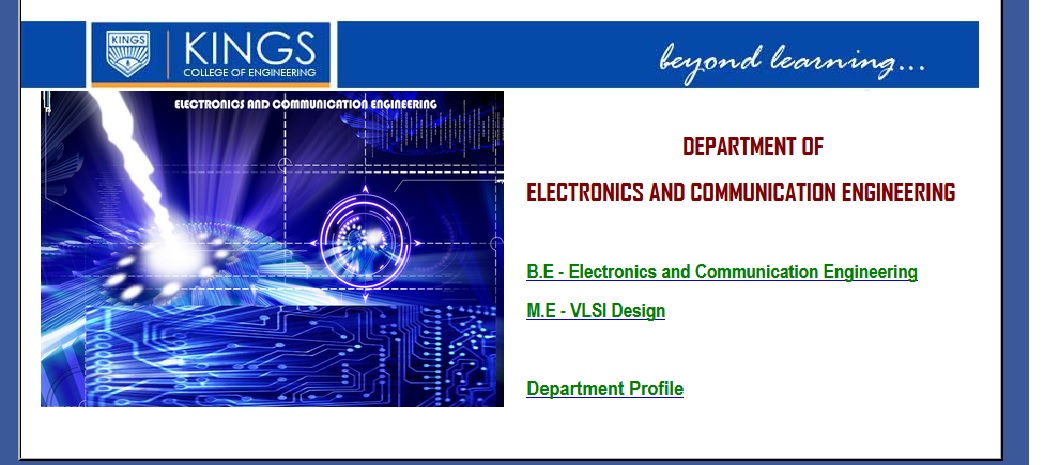EC2252 Linear Integrated Circuits Question Bank : kings.ac.in
Name of the College : Kings College Of Engineering
Department : Electronics & Communication Engineering
Subject : Linear Integrated Circuits
Website : kings.ac.in
Document Type : Question Bank
Download Model/Sample Question Paper : https://www.pdfquestion.in/uploads/ki…20CIRCUITS.pdf
Kings Linear Integrated Circuits Question Paper
Unit – I
IC Fabrication And Circuit Configuration For Linear IC’S :
Part A :(2 Marks)
1. What are the popular IC packages available?
2. Define CMRR of an op-amp.
3. What causes slew rate?
4. Define PSRR or SVRR or PSS.
Related : Kings College Of Engineering ME2255 Electronics & Microprocessors Question Bank : www.pdfquestion.in/1416.html
5. Define slew rate.
6. What is the need for frequency compensation in practical op-amps?
7. What do you mean by balanced and unbalanced output?
8. What is loading effect? How can you reduce it?
9. What is an ideal op-amp?
10. What is input offset voltage?
11. What is input off set current?
12. What is input bias current?
13. Draw the circuit of a Widlar current source and write the expression for its output current?

Part B :(16 Marks)
1. Obtain the frequency response of an open-loop op-amp (16)
2. Explain the operation of a basic differential amplifier? (16)
3. Derive the transfer characteristics of differential amplifier or sketch the transfer characteristics of dual input differential amplifier showing the linear and limiting regions. Comment on the same. (16)
4. Design an active load for an emitter-coupled pair (differential amplifier) and perform a detailed analysis to find its differential mode gain and the output resistance. (16)
5. Design a Widlar current source and obtain the expression for output current. Also prove that widlar current source has better sensitivity than constant current source. (16)
6. Explain the supply independent biasing technique using VBE as the reference voltage. Also, find the dependence of its output current on temperature. (16)
7. Explain supply independent biasing using Zener-referenced bias circuit. Also, design a temperature compensated Zener-reference source. (16)
8. Discuss about the methods of frequency compensation. (16)
Unit – II
Applications Of Operational Amplifiers :
Part A : (2 Marks)
1. Mention some of the linear applications of op – amps :
2. Mention some of the non – linear applications of op-amps :-
3. What are the areas of application of non-linear op- amp circuits?
4. What is the need for an instrumentation amplifier?
5. List the features of instrumentation amplifier :
6. What are the applications of V-I converter?
7. What do you mean by a precision diode?
8. Write down the applications of precision diode.
9. List the applications of Log amplifiers :
10. What are the limitations of the basic differentiator circuit?
11. Write down the condition for good differentiation :-
12. What is a comparator?
13. What are the applications of comparator?
14. What is a Schmitt trigger?
15. What is a multivibrator?
16. What do you mean by monostable multivibrator?
17. What is an astable multivibrator?
18. What is a bistable multivibrator?
19. What are the requirements for producing sustained oscillations in feedback circuits? For sustained oscillations,
20. Mention any two audio frequency oscillators :
21. What are the characteristics of a comparator?
22. What is a filter?
23. What are the demerits of passive filters?
24. What are the advantages of active filters?
25. Mention some commonly used active filters :
Part B : (16 Marks)
1. Discuss the need for an instrumentation amplifier? Give a detailed analysis for the same. (16)
2. Explain the operation of the Schmitt trigger. (16)
3. Detail the logarithmic and anti logarithmic amplifier? (16)
4. With circuit diagram discuss the following applications of opamp. (16)
5. Draw the circuit diagram of a second order Butterworth active low pass filter and derive an expression for its transfer function and explain a second order low pass filter (16)
Unit – III
Analog Multiplier And PLL :
Part-A : ( 2Marks )
1. Mention some areas where PLL is widely used :
2. List the basic building blocks of PLL :
3. What are the three stages through which PLL operates?
4. Define lock-in range of a PLL :
5. Define capture range of PLL :
6. Define Pull-in time.
7. For perfect lock, what should be the phase relation between the incoming signal and VCO output signal?
8. Give the classification of phase detector :
9. What is a principle of analog phase detector?
10. What are the problems associated with switch type phase detector?
11. What is a voltage controlled oscillator?
12. On what parameters does the free running frequency of VCO depend on?
13. Give the expression for the VCO free running frequency.
14. Define Voltage to Frequency conversion factor.
15. What is the purpose of having a low pass filter in PLL?
16. Discuss the effect of having large capture range.
17. Mention some typical applications of PLL :
18. What is a compander IC? Give some examples.
19. What are the merits of companding?
20. List the applications of OTA :
Part B : (16 Marks)
1. Briefly explain the block diagram of PLL and derive the expression for Lock range and capture range. (16)
2. With a neat functional diagram, explain the operation of VCO. Also derive an expression for fo. (16)
3. Analyze the Gilbert’s four quadrant multiplier cell with a neat circuit diagram. Discuss its applications. (16)
4. In detail discuss the applications of PLL : (16)
5. With a neat sketch, explain the working of variable transconductance multiplier. (16)